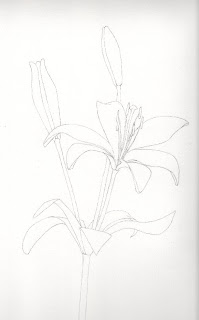This is a graphite drawing I did of a Douglas Fir cone, Pseudotsuga menzeisii, for the course I am taking from the Society of Botanical Artists. I chose this particular tree because it is native to the Pacific Northwest where I live, and besides who can resist the beautiful fringes that dangle from the cone? I felt like I was doing the portrait of an old friend, since I have seen and lived near Douglas Fir trees most of my life. One of my early childhood memories is of three firs that I could see in the distance from my house. I imagined that they were three sisters having a long intimate conversation. Maybe the way the wind in the branches makes a whispering sound suggested it to me.
I just finished my first assignment which had three parts. Part One was to produce a line drawing in pencil or ink. I decided I would play it safe and do it in pencil. The pencil lines were to be lightly drawn, as if for a preliminary drawing for a water color. We were supposed to chose a subject with a simple clean line, and include the supporting stem of the flower or leaf. I bought an Asiatic lily from the supermarket, and proceeded to carefully recreate it on paper. I didn’t realize that one of its petals was missing until another bud opened up and–yikes! All of our drawings are supposed to be botanically correct, so this would have had a major affect on my evaluation. Fortunately, I had been accurate enough in my drawing, that I was able to simply fill in another petal where it should have been! Whew!
The second part was to make a small study of a single flower with leaf and stem, using stippling to give tonal variation and form. I chose a flower from a Yuletide Camellia, which had been in bloom outside my kitchen window all winter. (It is still in bloom!) I’ve never done stippling before, but surprisingly, rather than being tedious, making zillions of little dots turned out to be rather relaxing once I got into it. I used a Pigma Micron 005, and Pitt Artist XS and S pens.
Part Three of the assignment was to do a complete study with “continuous tone” with graphite. I did the Douglas Fir branchlet and cone at the top of the post. Also we were to make a tonal chart with a spectrum of pencil grades, to help evaluate whether we used a full range of tone in our drawing. I used Derwent Graphic pencils for this entire exercise. Making the chart increased my awareness of the characteristics of the various grades of pencils. I made the chart before I did the drawing, so found myself using more pencil grades in the Douglas Fir drawing than I ever have before.
My next assignment will be in monochrome as well and is due in mid-April–but more about that later! I have been feeling that I needed direction and discipline in my artistic endeavors, and this course has been very helpful to me already. I actually feel more motivated to be looser in my sketches (one of my many goals), since I have a way to get my perfectionist urges out now! But just remember that “loose” is a relative term!
Addendum: Tutor’s Comments & My Reflections:
My tutor’s evaluation and comments on this assignment were a wake-up call that I needed to ‘up my game’ if I was going to succeed in this course. I had never taken a botanical art class before and hadn’t even been to a botanical art exhibition, since neither were available in my region. I had little idea of the standards that were expected or how to achieve them…I just knew that I loved this genre of art and wanted to excel in the course if I could.
My tutor gave me two pages of commentary plus some tracing paper overlays to indicate areas of critique, so I will summarize for you lest this post become a book!
- Asiatic Lily line drawing–She noted that although I captured the character of the lily, my line drawing had wavering, hesitant lines, particularly along the stem. She reminded me to be particularly attentive to how the petals attach to the stem and to make sure the stamens follow the natural line of the stem. This is invaluable advice, which I think of every time I draw a blossom. Also she noted that I drew the angles of the leaves too sharply where they bend or fold. She also noted that I should finish my stem correctly. She advised me to practice drawing sweeping, smooth lines in my sketchbook.
- Stippled ink Yuletide Camellia–She said the presentation was neat, the flower showed effort, and my stipples generally showed the contour of the petals. The complex center showed the fluffy texture but had become overworked. My leaves were too dark and didn’t show venation. Again, I did not close the end of the stem correctly. She advised that I do a small camellia leaf study in stippling my sketchbook. I did some stippling exercises later, but chose Sarcococca leaves and a Flowering Quince twig instead of a Camellia leaf, which has almost no visible venation. Sarcococca leaves have the same thickness and texture of Camellia leaves but the venation is more prominent.
- Tonal study of Douglas fir twig–This piece received the most critique of all–almost one full page of commentary plus an overlay with notes. On the other parts of the assignment, I wasn’t sure if I was on the right track but was pretty confident of this drawing when I sent it in. It was by far the best thing I had ever drawn and the most complex. I found out how far I had to go when I got my tutor’s feedback. She noted that in general it was a pleasing study with good tonal variation, although it could use some more shading along the shadow side of the cone. The needles needed more clarity, particularly where they attach to the branch. I was shocked to learn than three of the needles got lost in the overlap with others and didn’t attach to the branch at all! She gave me detailed advice on how to hold my pencil and which grades to use to get the desired effect.
All of this feedback gave me good foundational knowledge of what was expected. I made a lot of mistakes but made sure not to make them again, although I still had many new mistakes to make on future assignments! My score for this assignment was the lowest I got in the whole course, which meant I had to work all that much harder to bring my average up to where I wanted it.







 This blog is about my journey as a botanical artist--what I am learning, what inspires me and what I am currently drawing or painting. My desire is to continually hone my skills to better express my wonder and gratitude for the beauty of the creation around me in the Pacific Northwest (USA).
This blog is about my journey as a botanical artist--what I am learning, what inspires me and what I am currently drawing or painting. My desire is to continually hone my skills to better express my wonder and gratitude for the beauty of the creation around me in the Pacific Northwest (USA).
Congratulations on being accepted for this course – looks like you are loving it already! Great drawings Janene. I understand it’s a very challenging course – I don’t know if you’ve heard of this book –
http://www.amazon.com/Botanical-Sketchbook-Mary-Ann-Scott/dp/1596682329/ref=sr_1_1?ie=UTF8&qid=1297759659&sr=8-1
but it’s by a student and tutor from the course.
Thanks, Sarah! How fun that you are familiar with the course! Actually, I have been referring to that book a lot. It is one of the three textbooks for the course. Btw, all three books are excellent references, imo.
Great fir cone Janene!What a lovely course to do
Thanks Debra, I am looking forward to it.
These are all fabulous Janene. Congratulations are so successfully completing your first assignment.
This is really interesting to see how you do your assignments, I hope you show us more. Great work too!
I went and checked out the course…wow! Congratulations! These are wonderful!
Thanks for your interest, Sue, Cathy and Raena!
Janene, I have a little internal newsletter that has to do with tree species in the South and the Pacific Northwest. Could I use your drawing of Douglas-fir for the upper corner of the page?
Early
Early, I think that would be okay. What sort of organization is it? Thanks for asking first!!